Health Issues and Rehabilitation Strategies
VerifiedAdded on 2023/04/21
|14
|2724
|221
AI Summary
This document discusses various health issues and rehabilitation strategies for chronic conditions. It covers symptoms, treatment options, and management techniques. The document also provides information on community agencies and support services available for individuals with chronic conditions. Additionally, it explores different rehabilitation strategies, such as physiotherapy, hydrotherapy, and art therapy, that can help improve mobility and overall well-being. Overall, this document serves as a comprehensive guide for understanding and managing health issues and promoting rehabilitation.
Contribute Materials
Your contribution can guide someone’s learning journey. Share your
documents today.

Running Head: HEALTH ISSUES
0
Nursing
Student
0
Nursing
Student
Secure Best Marks with AI Grader
Need help grading? Try our AI Grader for instant feedback on your assignments.

HEALTH ISSUES
1
Table of Contents
Part A.........................................................................................................................................2
Part 2..........................................................................................................................................9
References................................................................................................................................11
1
Table of Contents
Part A.........................................................................................................................................2
Part 2..........................................................................................................................................9
References................................................................................................................................11
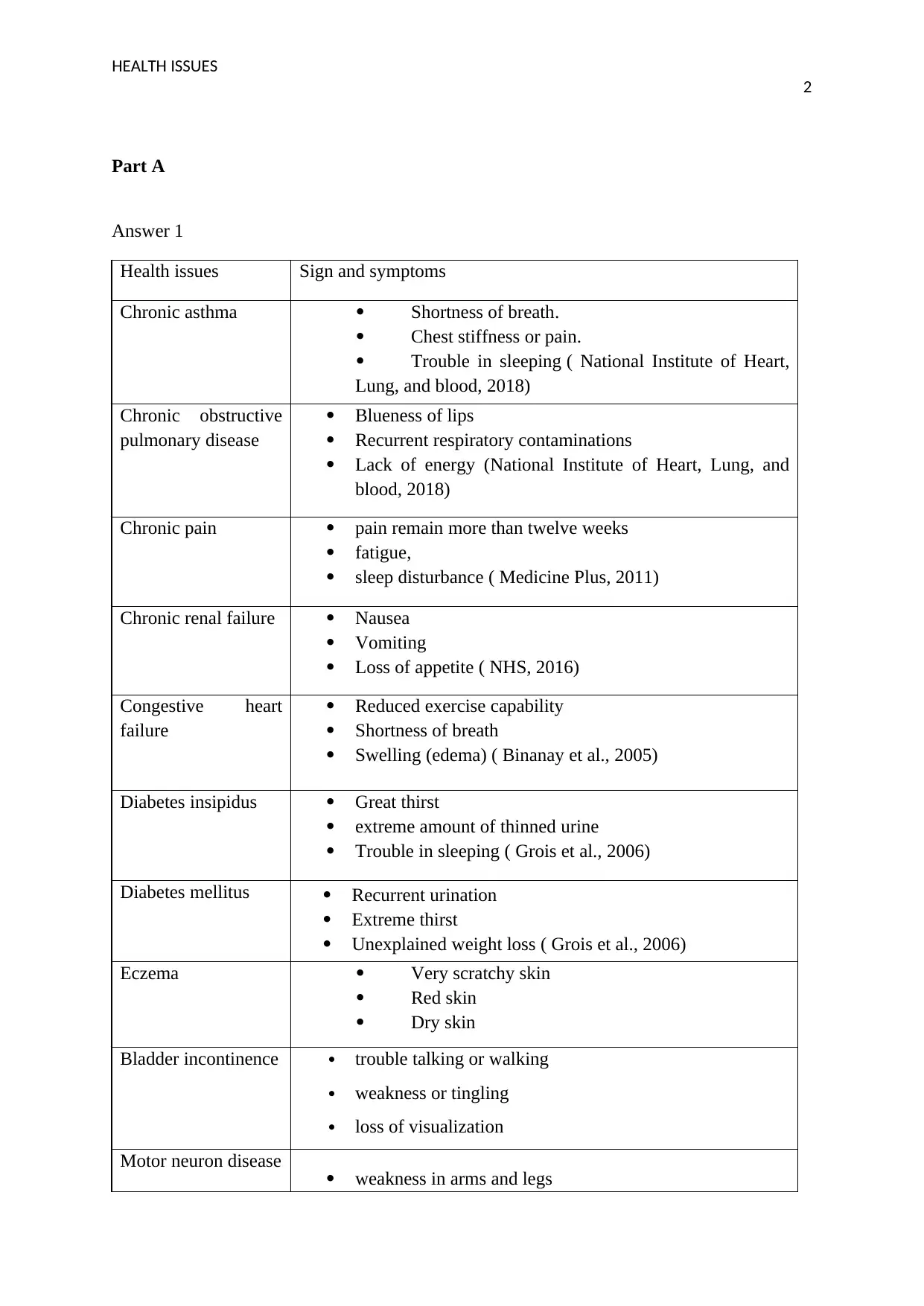
HEALTH ISSUES
2
Part A
Answer 1
Health issues Sign and symptoms
Chronic asthma Shortness of breath.
Chest stiffness or pain.
Trouble in sleeping ( National Institute of Heart,
Lung, and blood, 2018)
Chronic obstructive
pulmonary disease
Blueness of lips
Recurrent respiratory contaminations
Lack of energy (National Institute of Heart, Lung, and
blood, 2018)
Chronic pain pain remain more than twelve weeks
fatigue,
sleep disturbance ( Medicine Plus, 2011)
Chronic renal failure Nausea
Vomiting
Loss of appetite ( NHS, 2016)
Congestive heart
failure
Reduced exercise capability
Shortness of breath
Swelling (edema) ( Binanay et al., 2005)
Diabetes insipidus Great thirst
extreme amount of thinned urine
Trouble in sleeping ( Grois et al., 2006)
Diabetes mellitus Recurrent urination
Extreme thirst
Unexplained weight loss ( Grois et al., 2006)
Eczema Very scratchy skin
Red skin
Dry skin
Bladder incontinence trouble talking or walking
weakness or tingling
loss of visualization
Motor neuron disease weakness in arms and legs
2
Part A
Answer 1
Health issues Sign and symptoms
Chronic asthma Shortness of breath.
Chest stiffness or pain.
Trouble in sleeping ( National Institute of Heart,
Lung, and blood, 2018)
Chronic obstructive
pulmonary disease
Blueness of lips
Recurrent respiratory contaminations
Lack of energy (National Institute of Heart, Lung, and
blood, 2018)
Chronic pain pain remain more than twelve weeks
fatigue,
sleep disturbance ( Medicine Plus, 2011)
Chronic renal failure Nausea
Vomiting
Loss of appetite ( NHS, 2016)
Congestive heart
failure
Reduced exercise capability
Shortness of breath
Swelling (edema) ( Binanay et al., 2005)
Diabetes insipidus Great thirst
extreme amount of thinned urine
Trouble in sleeping ( Grois et al., 2006)
Diabetes mellitus Recurrent urination
Extreme thirst
Unexplained weight loss ( Grois et al., 2006)
Eczema Very scratchy skin
Red skin
Dry skin
Bladder incontinence trouble talking or walking
weakness or tingling
loss of visualization
Motor neuron disease weakness in arms and legs
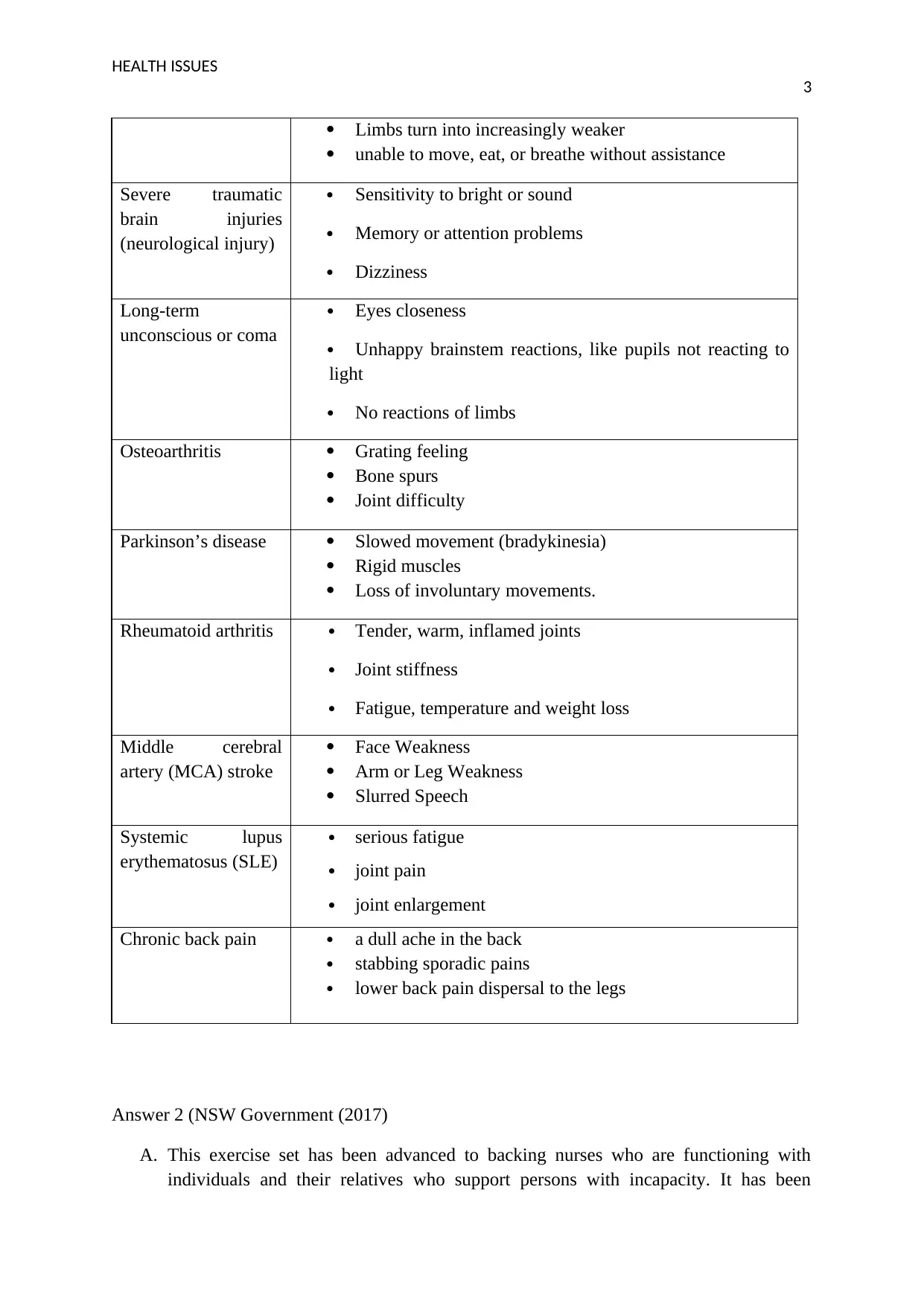
HEALTH ISSUES
3
Limbs turn into increasingly weaker
unable to move, eat, or breathe without assistance
Severe traumatic
brain injuries
(neurological injury)
Sensitivity to bright or sound
Memory or attention problems
Dizziness
Long-term
unconscious or coma
Eyes closeness
Unhappy brainstem reactions, like pupils not reacting to
light
No reactions of limbs
Osteoarthritis Grating feeling
Bone spurs
Joint difficulty
Parkinson’s disease Slowed movement (bradykinesia)
Rigid muscles
Loss of involuntary movements.
Rheumatoid arthritis Tender, warm, inflamed joints
Joint stiffness
Fatigue, temperature and weight loss
Middle cerebral
artery (MCA) stroke
Face Weakness
Arm or Leg Weakness
Slurred Speech
Systemic lupus
erythematosus (SLE)
serious fatigue
joint pain
joint enlargement
Chronic back pain a dull ache in the back
stabbing sporadic pains
lower back pain dispersal to the legs
Answer 2 (NSW Government (2017)
A. This exercise set has been advanced to backing nurses who are functioning with
individuals and their relatives who support persons with incapacity. It has been
3
Limbs turn into increasingly weaker
unable to move, eat, or breathe without assistance
Severe traumatic
brain injuries
(neurological injury)
Sensitivity to bright or sound
Memory or attention problems
Dizziness
Long-term
unconscious or coma
Eyes closeness
Unhappy brainstem reactions, like pupils not reacting to
light
No reactions of limbs
Osteoarthritis Grating feeling
Bone spurs
Joint difficulty
Parkinson’s disease Slowed movement (bradykinesia)
Rigid muscles
Loss of involuntary movements.
Rheumatoid arthritis Tender, warm, inflamed joints
Joint stiffness
Fatigue, temperature and weight loss
Middle cerebral
artery (MCA) stroke
Face Weakness
Arm or Leg Weakness
Slurred Speech
Systemic lupus
erythematosus (SLE)
serious fatigue
joint pain
joint enlargement
Chronic back pain a dull ache in the back
stabbing sporadic pains
lower back pain dispersal to the legs
Answer 2 (NSW Government (2017)
A. This exercise set has been advanced to backing nurses who are functioning with
individuals and their relatives who support persons with incapacity. It has been
Secure Best Marks with AI Grader
Need help grading? Try our AI Grader for instant feedback on your assignments.
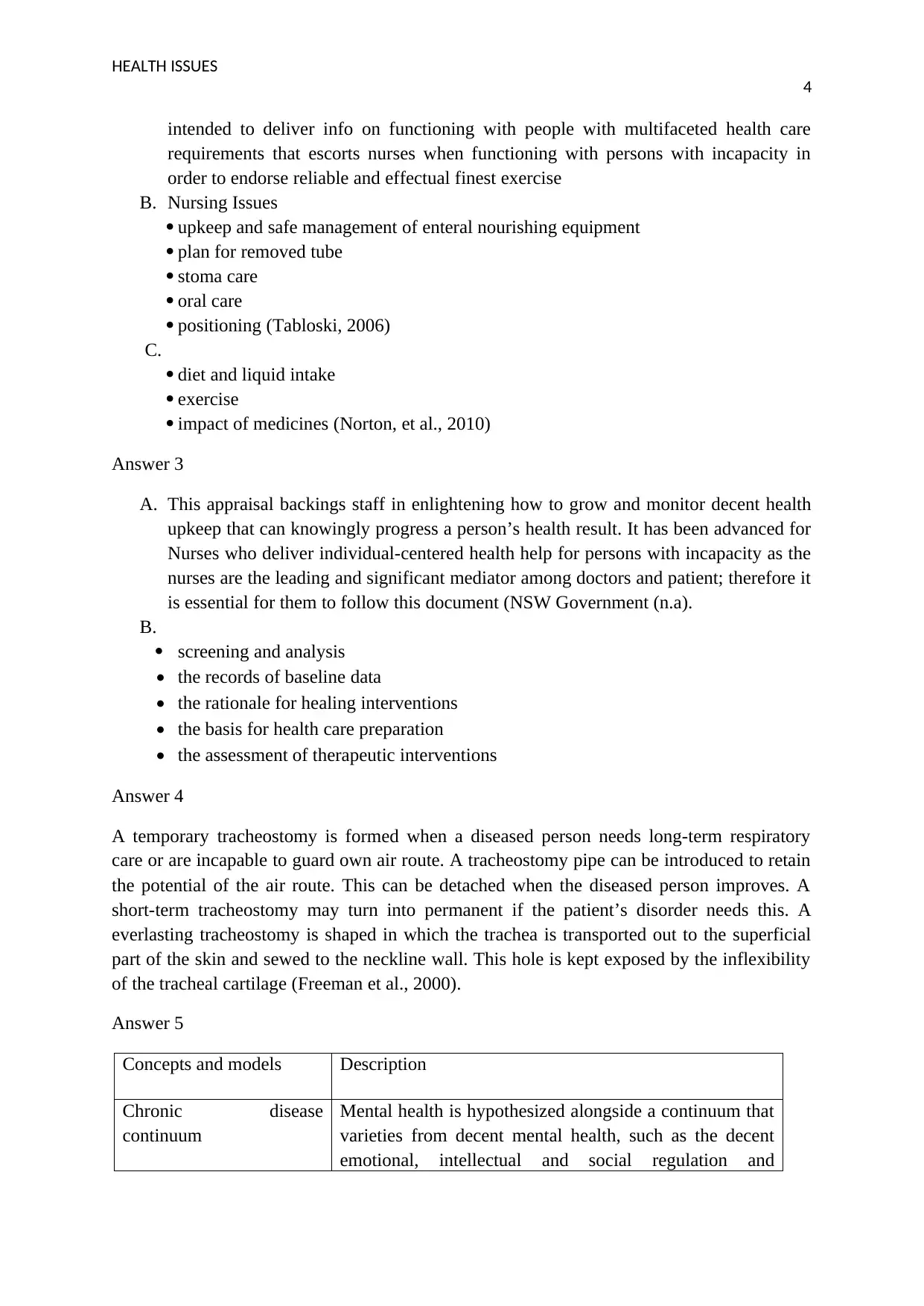
HEALTH ISSUES
4
intended to deliver info on functioning with people with multifaceted health care
requirements that escorts nurses when functioning with persons with incapacity in
order to endorse reliable and effectual finest exercise
B. Nursing Issues
upkeep and safe management of enteral nourishing equipment
plan for removed tube
stoma care
oral care
positioning (Tabloski, 2006)
C.
diet and liquid intake
exercise
impact of medicines (Norton, et al., 2010)
Answer 3
A. This appraisal backings staff in enlightening how to grow and monitor decent health
upkeep that can knowingly progress a person’s health result. It has been advanced for
Nurses who deliver individual-centered health help for persons with incapacity as the
nurses are the leading and significant mediator among doctors and patient; therefore it
is essential for them to follow this document (NSW Government (n.a).
B.
screening and analysis
• the records of baseline data
• the rationale for healing interventions
• the basis for health care preparation
• the assessment of therapeutic interventions
Answer 4
A temporary tracheostomy is formed when a diseased person needs long-term respiratory
care or are incapable to guard own air route. A tracheostomy pipe can be introduced to retain
the potential of the air route. This can be detached when the diseased person improves. A
short-term tracheostomy may turn into permanent if the patient’s disorder needs this. A
everlasting tracheostomy is shaped in which the trachea is transported out to the superficial
part of the skin and sewed to the neckline wall. This hole is kept exposed by the inflexibility
of the tracheal cartilage (Freeman et al., 2000).
Answer 5
Concepts and models Description
Chronic disease
continuum
Mental health is hypothesized alongside a continuum that
varieties from decent mental health, such as the decent
emotional, intellectual and social regulation and
4
intended to deliver info on functioning with people with multifaceted health care
requirements that escorts nurses when functioning with persons with incapacity in
order to endorse reliable and effectual finest exercise
B. Nursing Issues
upkeep and safe management of enteral nourishing equipment
plan for removed tube
stoma care
oral care
positioning (Tabloski, 2006)
C.
diet and liquid intake
exercise
impact of medicines (Norton, et al., 2010)
Answer 3
A. This appraisal backings staff in enlightening how to grow and monitor decent health
upkeep that can knowingly progress a person’s health result. It has been advanced for
Nurses who deliver individual-centered health help for persons with incapacity as the
nurses are the leading and significant mediator among doctors and patient; therefore it
is essential for them to follow this document (NSW Government (n.a).
B.
screening and analysis
• the records of baseline data
• the rationale for healing interventions
• the basis for health care preparation
• the assessment of therapeutic interventions
Answer 4
A temporary tracheostomy is formed when a diseased person needs long-term respiratory
care or are incapable to guard own air route. A tracheostomy pipe can be introduced to retain
the potential of the air route. This can be detached when the diseased person improves. A
short-term tracheostomy may turn into permanent if the patient’s disorder needs this. A
everlasting tracheostomy is shaped in which the trachea is transported out to the superficial
part of the skin and sewed to the neckline wall. This hole is kept exposed by the inflexibility
of the tracheal cartilage (Freeman et al., 2000).
Answer 5
Concepts and models Description
Chronic disease
continuum
Mental health is hypothesized alongside a continuum that
varieties from decent mental health, such as the decent
emotional, intellectual and social regulation and
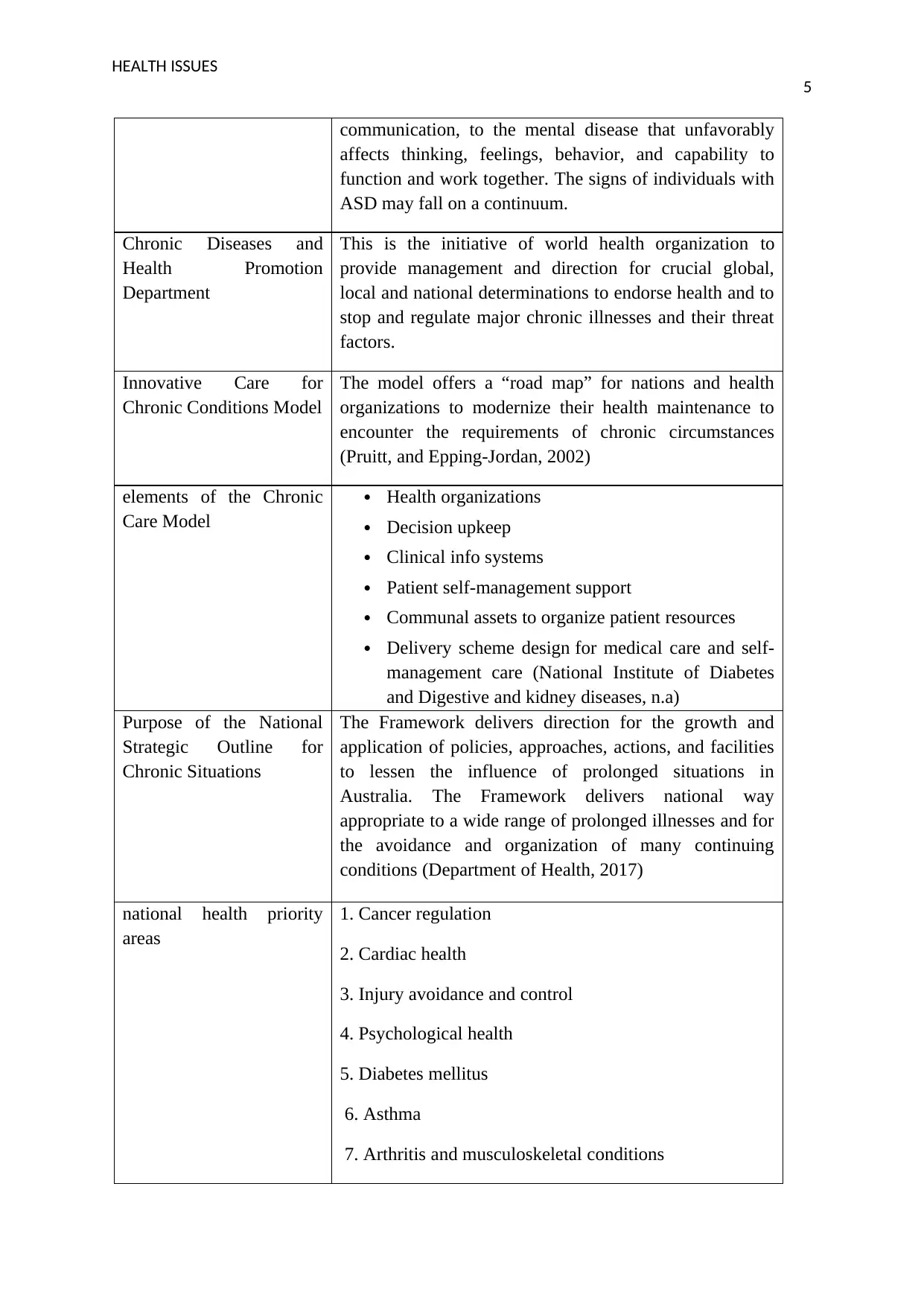
HEALTH ISSUES
5
communication, to the mental disease that unfavorably
affects thinking, feelings, behavior, and capability to
function and work together. The signs of individuals with
ASD may fall on a continuum.
Chronic Diseases and
Health Promotion
Department
This is the initiative of world health organization to
provide management and direction for crucial global,
local and national determinations to endorse health and to
stop and regulate major chronic illnesses and their threat
factors.
Innovative Care for
Chronic Conditions Model
The model offers a “road map” for nations and health
organizations to modernize their health maintenance to
encounter the requirements of chronic circumstances
(Pruitt, and Epping-Jordan, 2002)
elements of the Chronic
Care Model
Health organizations
Decision upkeep
Clinical info systems
Patient self-management support
Communal assets to organize patient resources
Delivery scheme design for medical care and self-
management care (National Institute of Diabetes
and Digestive and kidney diseases, n.a)
Purpose of the National
Strategic Outline for
Chronic Situations
The Framework delivers direction for the growth and
application of policies, approaches, actions, and facilities
to lessen the influence of prolonged situations in
Australia. The Framework delivers national way
appropriate to a wide range of prolonged illnesses and for
the avoidance and organization of many continuing
conditions (Department of Health, 2017)
national health priority
areas
1. Cancer regulation
2. Cardiac health
3. Injury avoidance and control
4. Psychological health
5. Diabetes mellitus
6. Asthma
7. Arthritis and musculoskeletal conditions
5
communication, to the mental disease that unfavorably
affects thinking, feelings, behavior, and capability to
function and work together. The signs of individuals with
ASD may fall on a continuum.
Chronic Diseases and
Health Promotion
Department
This is the initiative of world health organization to
provide management and direction for crucial global,
local and national determinations to endorse health and to
stop and regulate major chronic illnesses and their threat
factors.
Innovative Care for
Chronic Conditions Model
The model offers a “road map” for nations and health
organizations to modernize their health maintenance to
encounter the requirements of chronic circumstances
(Pruitt, and Epping-Jordan, 2002)
elements of the Chronic
Care Model
Health organizations
Decision upkeep
Clinical info systems
Patient self-management support
Communal assets to organize patient resources
Delivery scheme design for medical care and self-
management care (National Institute of Diabetes
and Digestive and kidney diseases, n.a)
Purpose of the National
Strategic Outline for
Chronic Situations
The Framework delivers direction for the growth and
application of policies, approaches, actions, and facilities
to lessen the influence of prolonged situations in
Australia. The Framework delivers national way
appropriate to a wide range of prolonged illnesses and for
the avoidance and organization of many continuing
conditions (Department of Health, 2017)
national health priority
areas
1. Cancer regulation
2. Cardiac health
3. Injury avoidance and control
4. Psychological health
5. Diabetes mellitus
6. Asthma
7. Arthritis and musculoskeletal conditions
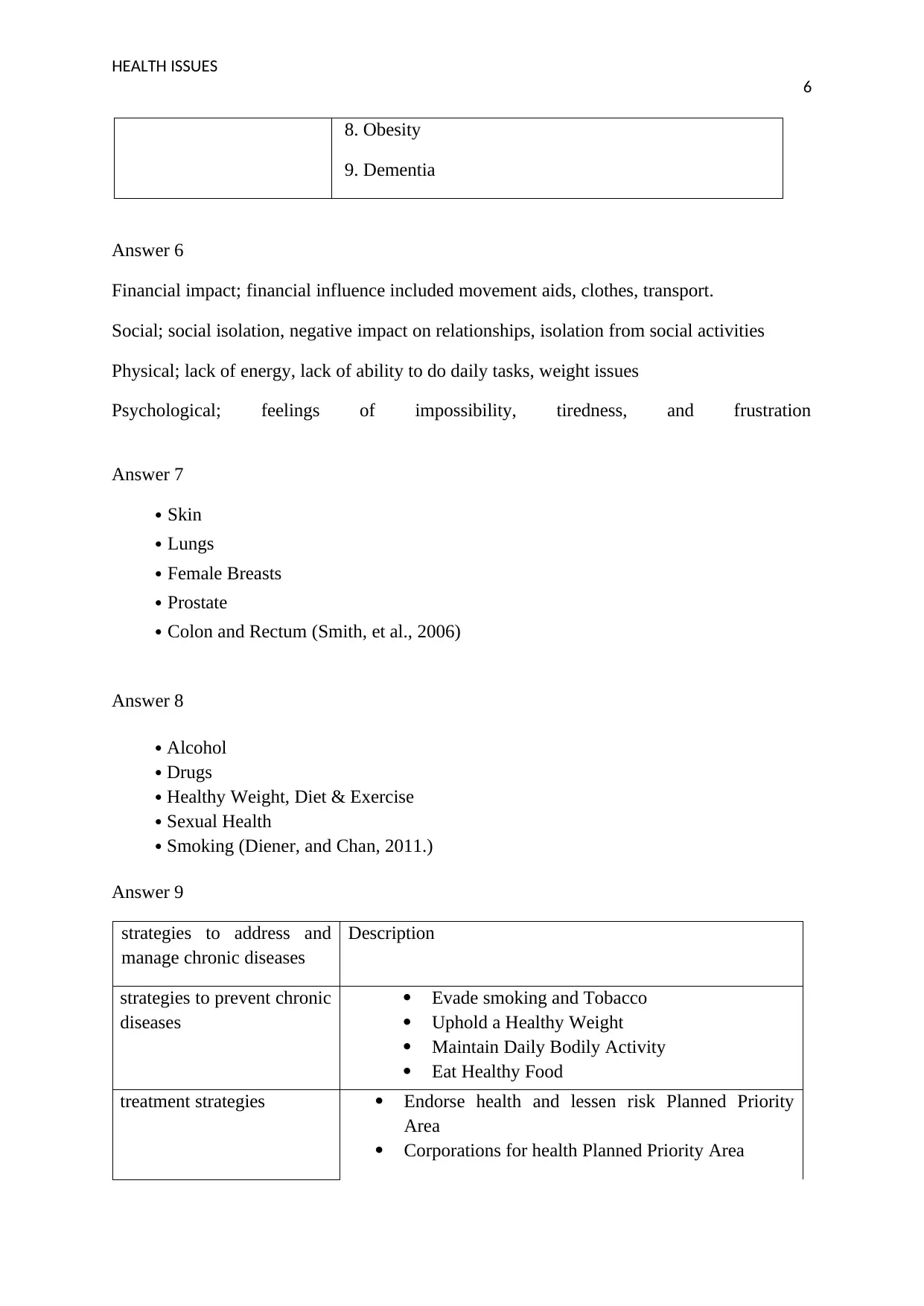
HEALTH ISSUES
6
8. Obesity
9. Dementia
Answer 6
Financial impact; financial influence included movement aids, clothes, transport.
Social; social isolation, negative impact on relationships, isolation from social activities
Physical; lack of energy, lack of ability to do daily tasks, weight issues
Psychological; feelings of impossibility, tiredness, and frustration
Answer 7
Skin
Lungs
Female Breasts
Prostate
Colon and Rectum (Smith, et al., 2006)
Answer 8
Alcohol
Drugs
Healthy Weight, Diet & Exercise
Sexual Health
Smoking (Diener, and Chan, 2011.)
Answer 9
strategies to address and
manage chronic diseases
Description
strategies to prevent chronic
diseases
Evade smoking and Tobacco
Uphold a Healthy Weight
Maintain Daily Bodily Activity
Eat Healthy Food
treatment strategies Endorse health and lessen risk Planned Priority
Area
Corporations for health Planned Priority Area
6
8. Obesity
9. Dementia
Answer 6
Financial impact; financial influence included movement aids, clothes, transport.
Social; social isolation, negative impact on relationships, isolation from social activities
Physical; lack of energy, lack of ability to do daily tasks, weight issues
Psychological; feelings of impossibility, tiredness, and frustration
Answer 7
Skin
Lungs
Female Breasts
Prostate
Colon and Rectum (Smith, et al., 2006)
Answer 8
Alcohol
Drugs
Healthy Weight, Diet & Exercise
Sexual Health
Smoking (Diener, and Chan, 2011.)
Answer 9
strategies to address and
manage chronic diseases
Description
strategies to prevent chronic
diseases
Evade smoking and Tobacco
Uphold a Healthy Weight
Maintain Daily Bodily Activity
Eat Healthy Food
treatment strategies Endorse health and lessen risk Planned Priority
Area
Corporations for health Planned Priority Area
Paraphrase This Document
Need a fresh take? Get an instant paraphrase of this document with our AI Paraphraser
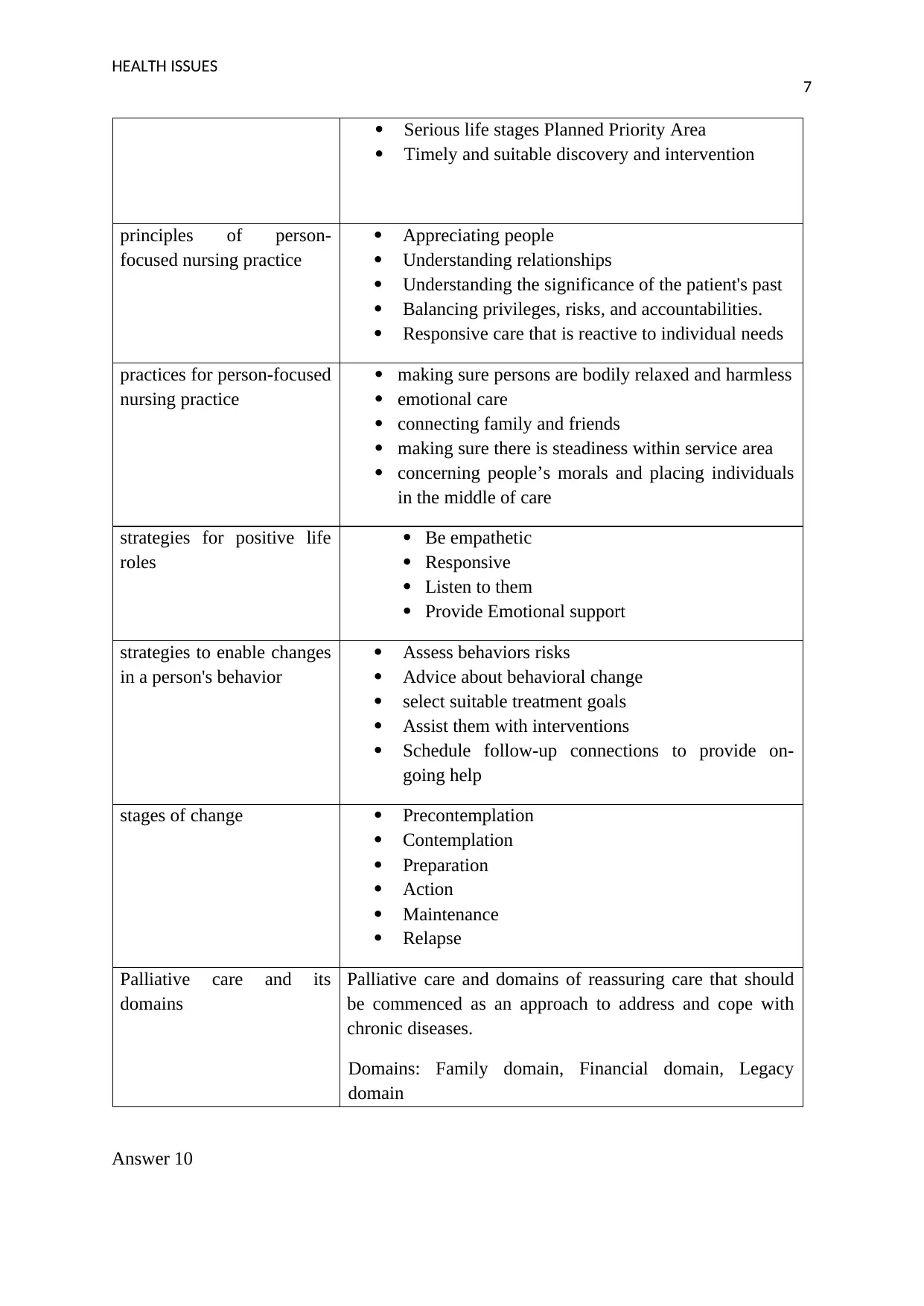
HEALTH ISSUES
7
Serious life stages Planned Priority Area
Timely and suitable discovery and intervention
principles of person-
focused nursing practice
Appreciating people
Understanding relationships
Understanding the significance of the patient's past
Balancing privileges, risks, and accountabilities.
Responsive care that is reactive to individual needs
practices for person-focused
nursing practice
making sure persons are bodily relaxed and harmless
emotional care
connecting family and friends
making sure there is steadiness within service area
concerning people’s morals and placing individuals
in the middle of care
strategies for positive life
roles
Be empathetic
Responsive
Listen to them
Provide Emotional support
strategies to enable changes
in a person's behavior
Assess behaviors risks
Advice about behavioral change
select suitable treatment goals
Assist them with interventions
Schedule follow-up connections to provide on-
going help
stages of change Precontemplation
Contemplation
Preparation
Action
Maintenance
Relapse
Palliative care and its
domains
Palliative care and domains of reassuring care that should
be commenced as an approach to address and cope with
chronic diseases.
Domains: Family domain, Financial domain, Legacy
domain
Answer 10
7
Serious life stages Planned Priority Area
Timely and suitable discovery and intervention
principles of person-
focused nursing practice
Appreciating people
Understanding relationships
Understanding the significance of the patient's past
Balancing privileges, risks, and accountabilities.
Responsive care that is reactive to individual needs
practices for person-focused
nursing practice
making sure persons are bodily relaxed and harmless
emotional care
connecting family and friends
making sure there is steadiness within service area
concerning people’s morals and placing individuals
in the middle of care
strategies for positive life
roles
Be empathetic
Responsive
Listen to them
Provide Emotional support
strategies to enable changes
in a person's behavior
Assess behaviors risks
Advice about behavioral change
select suitable treatment goals
Assist them with interventions
Schedule follow-up connections to provide on-
going help
stages of change Precontemplation
Contemplation
Preparation
Action
Maintenance
Relapse
Palliative care and its
domains
Palliative care and domains of reassuring care that should
be commenced as an approach to address and cope with
chronic diseases.
Domains: Family domain, Financial domain, Legacy
domain
Answer 10
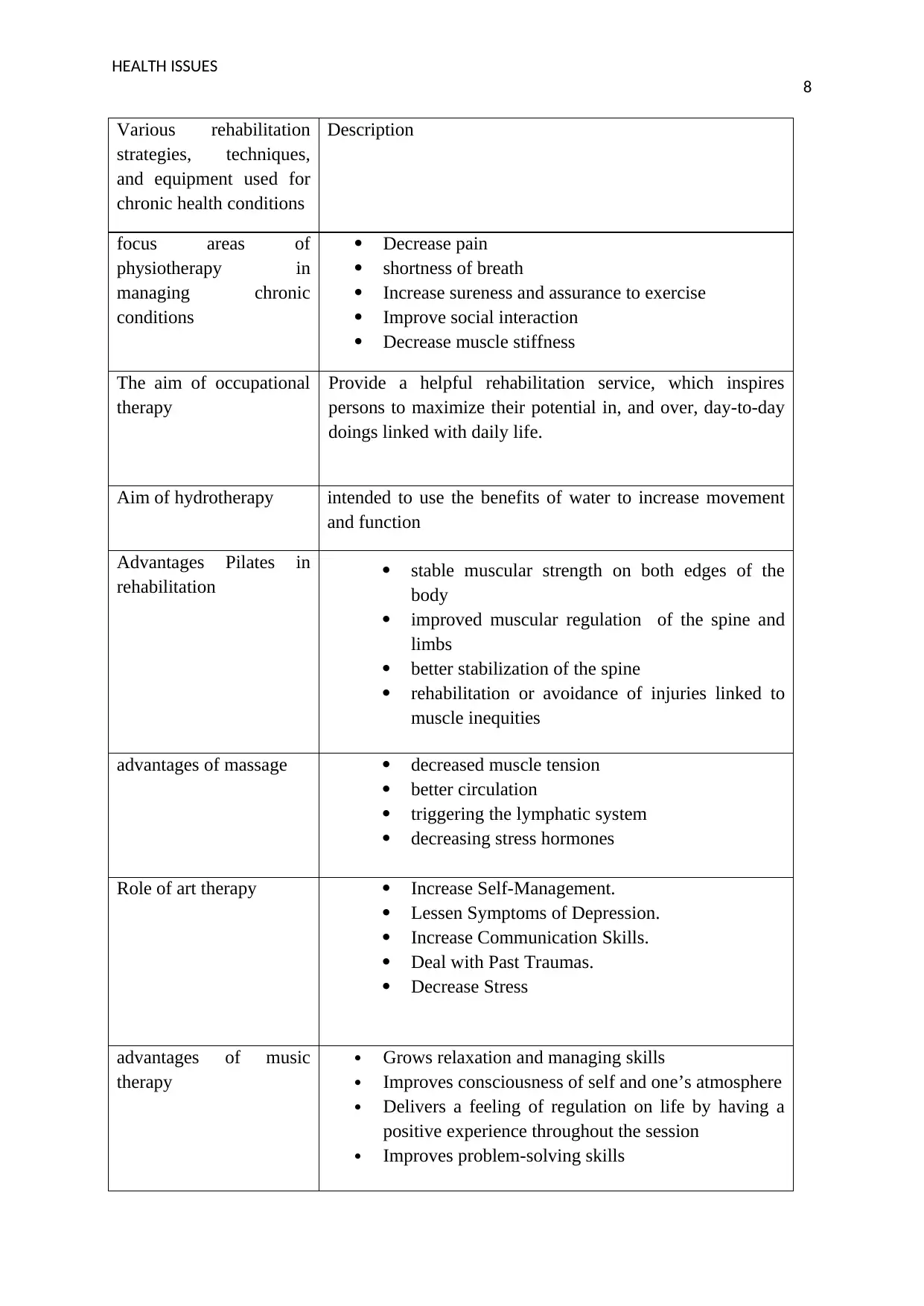
HEALTH ISSUES
8
Various rehabilitation
strategies, techniques,
and equipment used for
chronic health conditions
Description
focus areas of
physiotherapy in
managing chronic
conditions
Decrease pain
shortness of breath
Increase sureness and assurance to exercise
Improve social interaction
Decrease muscle stiffness
The aim of occupational
therapy
Provide a helpful rehabilitation service, which inspires
persons to maximize their potential in, and over, day-to-day
doings linked with daily life.
Aim of hydrotherapy intended to use the benefits of water to increase movement
and function
Advantages Pilates in
rehabilitation stable muscular strength on both edges of the
body
improved muscular regulation of the spine and
limbs
better stabilization of the spine
rehabilitation or avoidance of injuries linked to
muscle inequities
advantages of massage decreased muscle tension
better circulation
triggering the lymphatic system
decreasing stress hormones
Role of art therapy Increase Self-Management.
Lessen Symptoms of Depression.
Increase Communication Skills.
Deal with Past Traumas.
Decrease Stress
advantages of music
therapy
Grows relaxation and managing skills
Improves consciousness of self and one’s atmosphere
Delivers a feeling of regulation on life by having a
positive experience throughout the session
Improves problem-solving skills
8
Various rehabilitation
strategies, techniques,
and equipment used for
chronic health conditions
Description
focus areas of
physiotherapy in
managing chronic
conditions
Decrease pain
shortness of breath
Increase sureness and assurance to exercise
Improve social interaction
Decrease muscle stiffness
The aim of occupational
therapy
Provide a helpful rehabilitation service, which inspires
persons to maximize their potential in, and over, day-to-day
doings linked with daily life.
Aim of hydrotherapy intended to use the benefits of water to increase movement
and function
Advantages Pilates in
rehabilitation stable muscular strength on both edges of the
body
improved muscular regulation of the spine and
limbs
better stabilization of the spine
rehabilitation or avoidance of injuries linked to
muscle inequities
advantages of massage decreased muscle tension
better circulation
triggering the lymphatic system
decreasing stress hormones
Role of art therapy Increase Self-Management.
Lessen Symptoms of Depression.
Increase Communication Skills.
Deal with Past Traumas.
Decrease Stress
advantages of music
therapy
Grows relaxation and managing skills
Improves consciousness of self and one’s atmosphere
Delivers a feeling of regulation on life by having a
positive experience throughout the session
Improves problem-solving skills
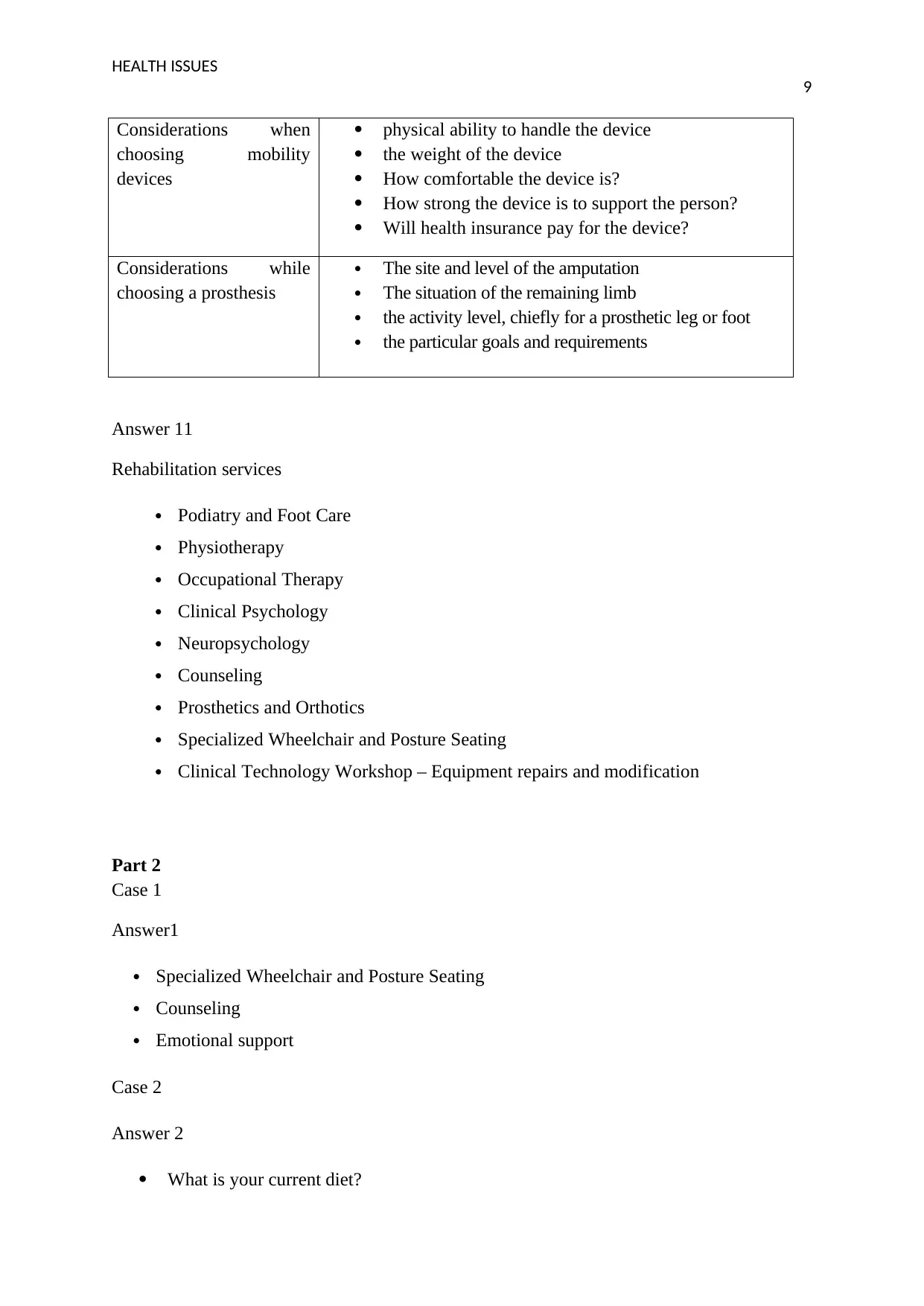
HEALTH ISSUES
9
Considerations when
choosing mobility
devices
physical ability to handle the device
the weight of the device
How comfortable the device is?
How strong the device is to support the person?
Will health insurance pay for the device?
Considerations while
choosing a prosthesis
The site and level of the amputation
The situation of the remaining limb
the activity level, chiefly for a prosthetic leg or foot
the particular goals and requirements
Answer 11
Rehabilitation services
Podiatry and Foot Care
Physiotherapy
Occupational Therapy
Clinical Psychology
Neuropsychology
Counseling
Prosthetics and Orthotics
Specialized Wheelchair and Posture Seating
Clinical Technology Workshop – Equipment repairs and modification
Part 2
Case 1
Answer1
Specialized Wheelchair and Posture Seating
Counseling
Emotional support
Case 2
Answer 2
What is your current diet?
9
Considerations when
choosing mobility
devices
physical ability to handle the device
the weight of the device
How comfortable the device is?
How strong the device is to support the person?
Will health insurance pay for the device?
Considerations while
choosing a prosthesis
The site and level of the amputation
The situation of the remaining limb
the activity level, chiefly for a prosthetic leg or foot
the particular goals and requirements
Answer 11
Rehabilitation services
Podiatry and Foot Care
Physiotherapy
Occupational Therapy
Clinical Psychology
Neuropsychology
Counseling
Prosthetics and Orthotics
Specialized Wheelchair and Posture Seating
Clinical Technology Workshop – Equipment repairs and modification
Part 2
Case 1
Answer1
Specialized Wheelchair and Posture Seating
Counseling
Emotional support
Case 2
Answer 2
What is your current diet?
Secure Best Marks with AI Grader
Need help grading? Try our AI Grader for instant feedback on your assignments.
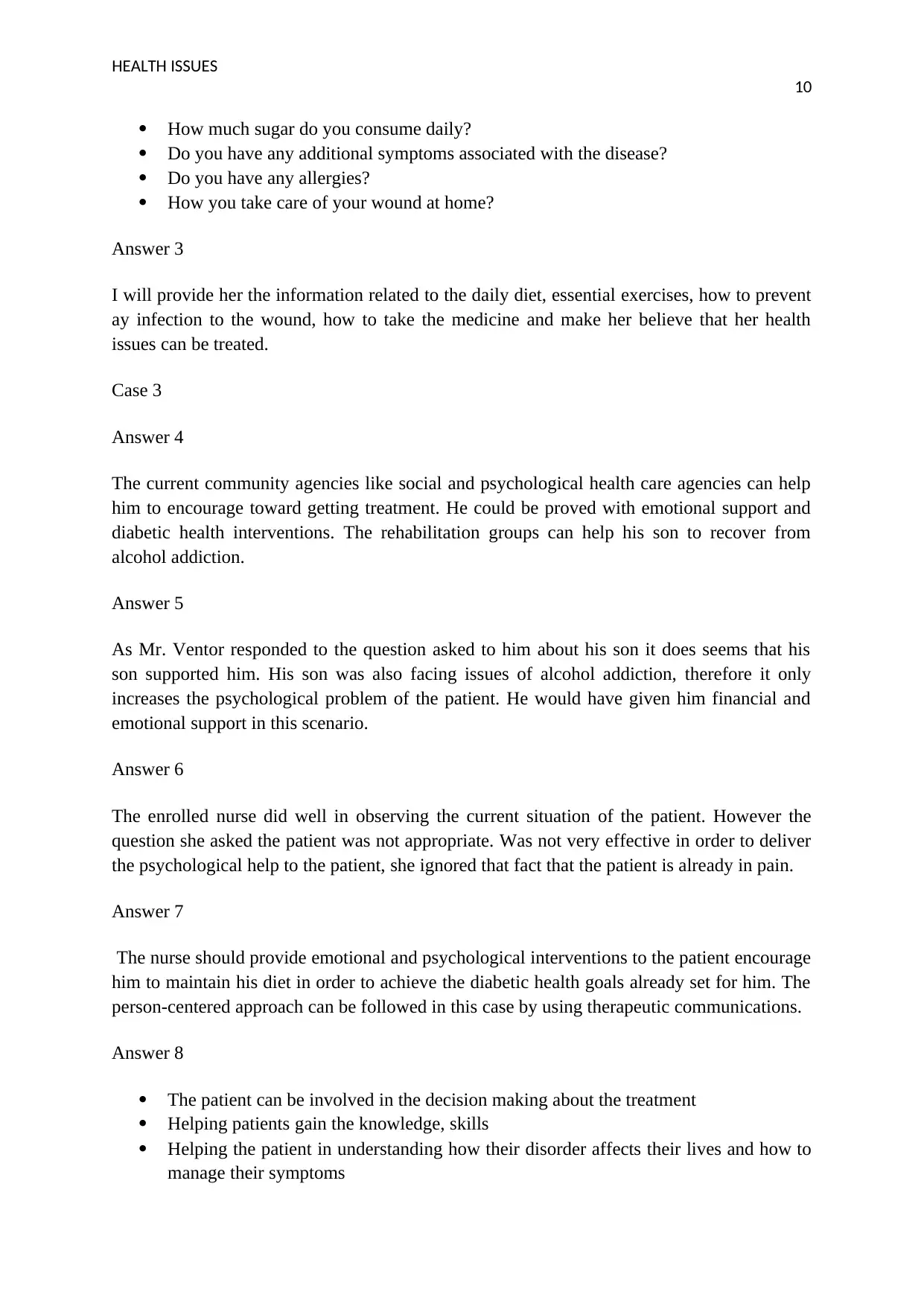
HEALTH ISSUES
10
How much sugar do you consume daily?
Do you have any additional symptoms associated with the disease?
Do you have any allergies?
How you take care of your wound at home?
Answer 3
I will provide her the information related to the daily diet, essential exercises, how to prevent
ay infection to the wound, how to take the medicine and make her believe that her health
issues can be treated.
Case 3
Answer 4
The current community agencies like social and psychological health care agencies can help
him to encourage toward getting treatment. He could be proved with emotional support and
diabetic health interventions. The rehabilitation groups can help his son to recover from
alcohol addiction.
Answer 5
As Mr. Ventor responded to the question asked to him about his son it does seems that his
son supported him. His son was also facing issues of alcohol addiction, therefore it only
increases the psychological problem of the patient. He would have given him financial and
emotional support in this scenario.
Answer 6
The enrolled nurse did well in observing the current situation of the patient. However the
question she asked the patient was not appropriate. Was not very effective in order to deliver
the psychological help to the patient, she ignored that fact that the patient is already in pain.
Answer 7
The nurse should provide emotional and psychological interventions to the patient encourage
him to maintain his diet in order to achieve the diabetic health goals already set for him. The
person-centered approach can be followed in this case by using therapeutic communications.
Answer 8
The patient can be involved in the decision making about the treatment
Helping patients gain the knowledge, skills
Helping the patient in understanding how their disorder affects their lives and how to
manage their symptoms
10
How much sugar do you consume daily?
Do you have any additional symptoms associated with the disease?
Do you have any allergies?
How you take care of your wound at home?
Answer 3
I will provide her the information related to the daily diet, essential exercises, how to prevent
ay infection to the wound, how to take the medicine and make her believe that her health
issues can be treated.
Case 3
Answer 4
The current community agencies like social and psychological health care agencies can help
him to encourage toward getting treatment. He could be proved with emotional support and
diabetic health interventions. The rehabilitation groups can help his son to recover from
alcohol addiction.
Answer 5
As Mr. Ventor responded to the question asked to him about his son it does seems that his
son supported him. His son was also facing issues of alcohol addiction, therefore it only
increases the psychological problem of the patient. He would have given him financial and
emotional support in this scenario.
Answer 6
The enrolled nurse did well in observing the current situation of the patient. However the
question she asked the patient was not appropriate. Was not very effective in order to deliver
the psychological help to the patient, she ignored that fact that the patient is already in pain.
Answer 7
The nurse should provide emotional and psychological interventions to the patient encourage
him to maintain his diet in order to achieve the diabetic health goals already set for him. The
person-centered approach can be followed in this case by using therapeutic communications.
Answer 8
The patient can be involved in the decision making about the treatment
Helping patients gain the knowledge, skills
Helping the patient in understanding how their disorder affects their lives and how to
manage their symptoms

HEALTH ISSUES
11
The usage of electronic instructive technology in learning and teaching, delivering
data for patients
An contract between the diseased person and their health care providers inpatient
notes
Behavioral change therapies should be implemented in the treatment care for the
patient in order to change his behaviors toward the daily healthy diet
11
The usage of electronic instructive technology in learning and teaching, delivering
data for patients
An contract between the diseased person and their health care providers inpatient
notes
Behavioral change therapies should be implemented in the treatment care for the
patient in order to change his behaviors toward the daily healthy diet
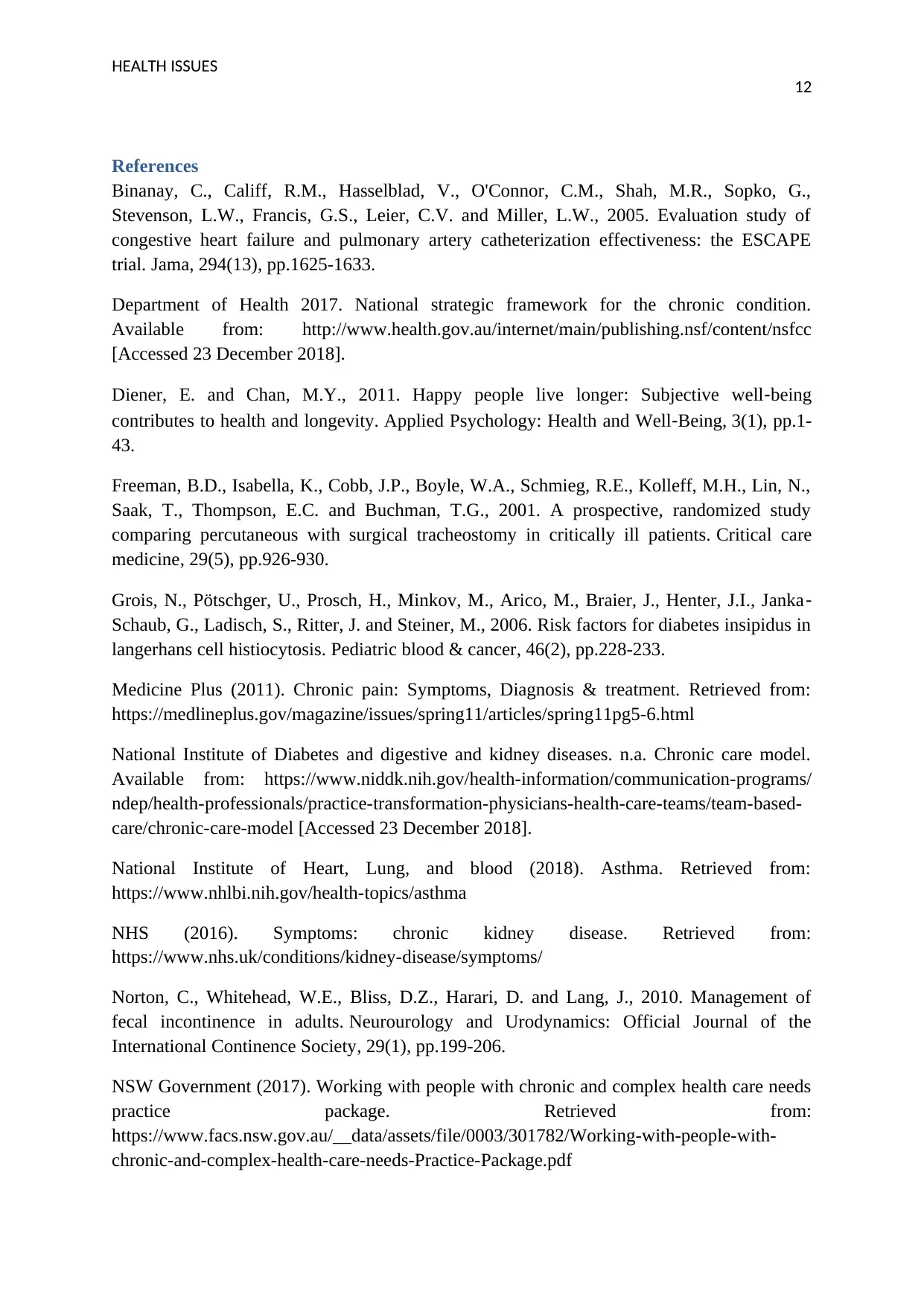
HEALTH ISSUES
12
References
Binanay, C., Califf, R.M., Hasselblad, V., O'Connor, C.M., Shah, M.R., Sopko, G.,
Stevenson, L.W., Francis, G.S., Leier, C.V. and Miller, L.W., 2005. Evaluation study of
congestive heart failure and pulmonary artery catheterization effectiveness: the ESCAPE
trial. Jama, 294(13), pp.1625-1633.
Department of Health 2017. National strategic framework for the chronic condition.
Available from: http://www.health.gov.au/internet/main/publishing.nsf/content/nsfcc
[Accessed 23 December 2018].
Diener, E. and Chan, M.Y., 2011. Happy people live longer: Subjective well‐being
contributes to health and longevity. Applied Psychology: Health and Well‐Being, 3(1), pp.1-
43.
Freeman, B.D., Isabella, K., Cobb, J.P., Boyle, W.A., Schmieg, R.E., Kolleff, M.H., Lin, N.,
Saak, T., Thompson, E.C. and Buchman, T.G., 2001. A prospective, randomized study
comparing percutaneous with surgical tracheostomy in critically ill patients. Critical care
medicine, 29(5), pp.926-930.
Grois, N., Pötschger, U., Prosch, H., Minkov, M., Arico, M., Braier, J., Henter, J.I., Janka‐
Schaub, G., Ladisch, S., Ritter, J. and Steiner, M., 2006. Risk factors for diabetes insipidus in
langerhans cell histiocytosis. Pediatric blood & cancer, 46(2), pp.228-233.
Medicine Plus (2011). Chronic pain: Symptoms, Diagnosis & treatment. Retrieved from:
https://medlineplus.gov/magazine/issues/spring11/articles/spring11pg5-6.html
National Institute of Diabetes and digestive and kidney diseases. n.a. Chronic care model.
Available from: https://www.niddk.nih.gov/health-information/communication-programs/
ndep/health-professionals/practice-transformation-physicians-health-care-teams/team-based-
care/chronic-care-model [Accessed 23 December 2018].
National Institute of Heart, Lung, and blood (2018). Asthma. Retrieved from:
https://www.nhlbi.nih.gov/health-topics/asthma
NHS (2016). Symptoms: chronic kidney disease. Retrieved from:
https://www.nhs.uk/conditions/kidney-disease/symptoms/
Norton, C., Whitehead, W.E., Bliss, D.Z., Harari, D. and Lang, J., 2010. Management of
fecal incontinence in adults. Neurourology and Urodynamics: Official Journal of the
International Continence Society, 29(1), pp.199-206.
NSW Government (2017). Working with people with chronic and complex health care needs
practice package. Retrieved from:
https://www.facs.nsw.gov.au/__data/assets/file/0003/301782/Working-with-people-with-
chronic-and-complex-health-care-needs-Practice-Package.pdf
12
References
Binanay, C., Califf, R.M., Hasselblad, V., O'Connor, C.M., Shah, M.R., Sopko, G.,
Stevenson, L.W., Francis, G.S., Leier, C.V. and Miller, L.W., 2005. Evaluation study of
congestive heart failure and pulmonary artery catheterization effectiveness: the ESCAPE
trial. Jama, 294(13), pp.1625-1633.
Department of Health 2017. National strategic framework for the chronic condition.
Available from: http://www.health.gov.au/internet/main/publishing.nsf/content/nsfcc
[Accessed 23 December 2018].
Diener, E. and Chan, M.Y., 2011. Happy people live longer: Subjective well‐being
contributes to health and longevity. Applied Psychology: Health and Well‐Being, 3(1), pp.1-
43.
Freeman, B.D., Isabella, K., Cobb, J.P., Boyle, W.A., Schmieg, R.E., Kolleff, M.H., Lin, N.,
Saak, T., Thompson, E.C. and Buchman, T.G., 2001. A prospective, randomized study
comparing percutaneous with surgical tracheostomy in critically ill patients. Critical care
medicine, 29(5), pp.926-930.
Grois, N., Pötschger, U., Prosch, H., Minkov, M., Arico, M., Braier, J., Henter, J.I., Janka‐
Schaub, G., Ladisch, S., Ritter, J. and Steiner, M., 2006. Risk factors for diabetes insipidus in
langerhans cell histiocytosis. Pediatric blood & cancer, 46(2), pp.228-233.
Medicine Plus (2011). Chronic pain: Symptoms, Diagnosis & treatment. Retrieved from:
https://medlineplus.gov/magazine/issues/spring11/articles/spring11pg5-6.html
National Institute of Diabetes and digestive and kidney diseases. n.a. Chronic care model.
Available from: https://www.niddk.nih.gov/health-information/communication-programs/
ndep/health-professionals/practice-transformation-physicians-health-care-teams/team-based-
care/chronic-care-model [Accessed 23 December 2018].
National Institute of Heart, Lung, and blood (2018). Asthma. Retrieved from:
https://www.nhlbi.nih.gov/health-topics/asthma
NHS (2016). Symptoms: chronic kidney disease. Retrieved from:
https://www.nhs.uk/conditions/kidney-disease/symptoms/
Norton, C., Whitehead, W.E., Bliss, D.Z., Harari, D. and Lang, J., 2010. Management of
fecal incontinence in adults. Neurourology and Urodynamics: Official Journal of the
International Continence Society, 29(1), pp.199-206.
NSW Government (2017). Working with people with chronic and complex health care needs
practice package. Retrieved from:
https://www.facs.nsw.gov.au/__data/assets/file/0003/301782/Working-with-people-with-
chronic-and-complex-health-care-needs-Practice-Package.pdf
Paraphrase This Document
Need a fresh take? Get an instant paraphrase of this document with our AI Paraphraser
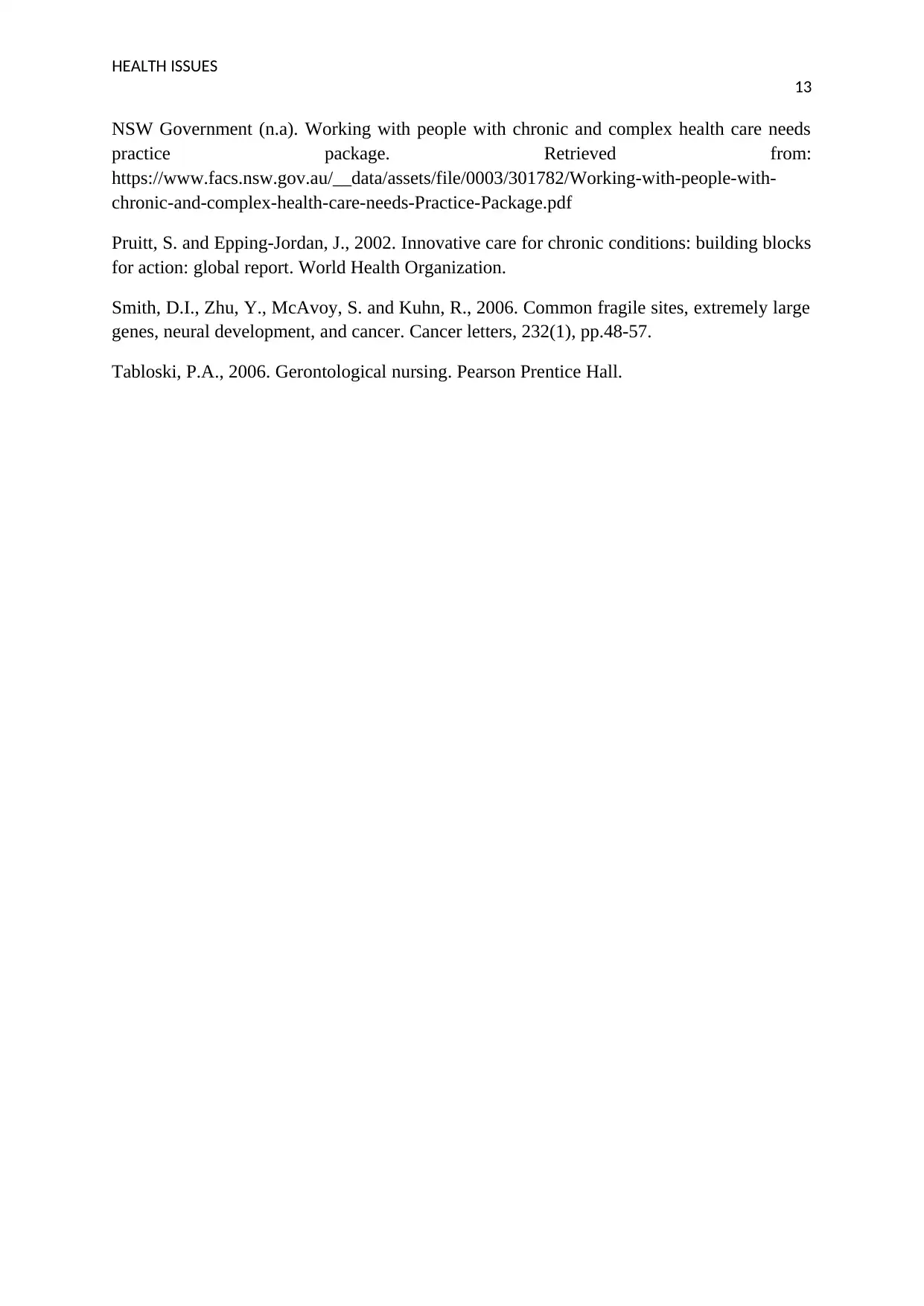
HEALTH ISSUES
13
NSW Government (n.a). Working with people with chronic and complex health care needs
practice package. Retrieved from:
https://www.facs.nsw.gov.au/__data/assets/file/0003/301782/Working-with-people-with-
chronic-and-complex-health-care-needs-Practice-Package.pdf
Pruitt, S. and Epping-Jordan, J., 2002. Innovative care for chronic conditions: building blocks
for action: global report. World Health Organization.
Smith, D.I., Zhu, Y., McAvoy, S. and Kuhn, R., 2006. Common fragile sites, extremely large
genes, neural development, and cancer. Cancer letters, 232(1), pp.48-57.
Tabloski, P.A., 2006. Gerontological nursing. Pearson Prentice Hall.
13
NSW Government (n.a). Working with people with chronic and complex health care needs
practice package. Retrieved from:
https://www.facs.nsw.gov.au/__data/assets/file/0003/301782/Working-with-people-with-
chronic-and-complex-health-care-needs-Practice-Package.pdf
Pruitt, S. and Epping-Jordan, J., 2002. Innovative care for chronic conditions: building blocks
for action: global report. World Health Organization.
Smith, D.I., Zhu, Y., McAvoy, S. and Kuhn, R., 2006. Common fragile sites, extremely large
genes, neural development, and cancer. Cancer letters, 232(1), pp.48-57.
Tabloski, P.A., 2006. Gerontological nursing. Pearson Prentice Hall.
1 out of 14
Related Documents
Your All-in-One AI-Powered Toolkit for Academic Success.
+13062052269
info@desklib.com
Available 24*7 on WhatsApp / Email
![[object Object]](/_next/static/media/star-bottom.7253800d.svg)
Unlock your academic potential
© 2024 | Zucol Services PVT LTD | All rights reserved.




